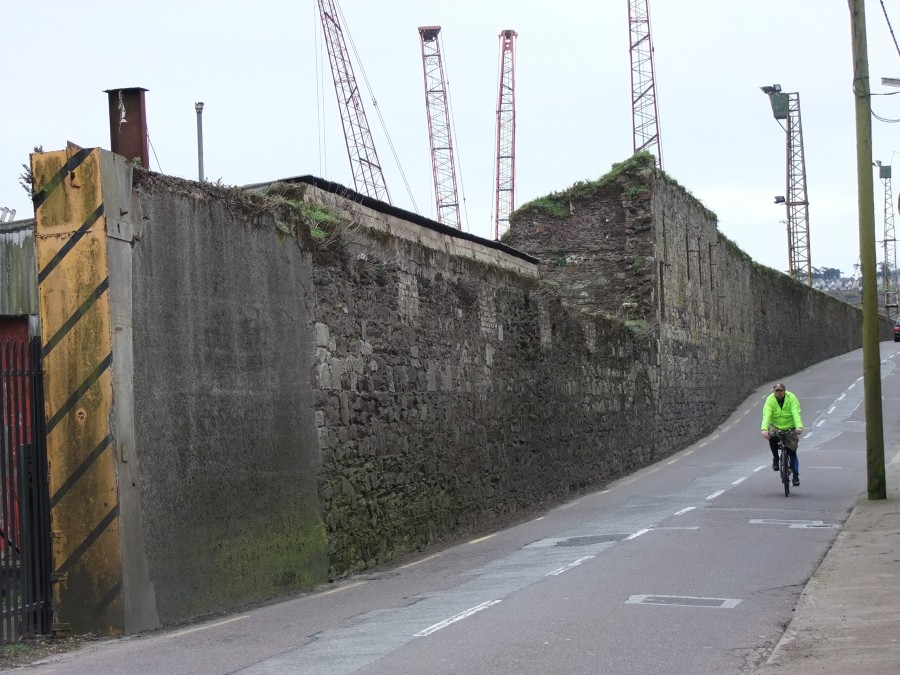The Entanglement of Place
Cllr Kieran McCarthy
Madame chairperson, colleagues, committee members, ladies and gentlemen,
Thanks for the invite this evening to this my eighth AGM; time flies.
It is great and frustrating to meet adjacent a building site – a half finished but ongoing project with lots of complexities to complete, entanglements to disentangle and lots of odds and ends to tie up, which we can discuss at length later this evening.
But it is clear that the DNA of the village is transforming once again and its public face is being redrawn and renewed,
– where the element of what makes up a place gets unpacked and repacked,
– where mixed emotions and questions move and are fluid,
– where childhood and family spaces are turned over,
– where the everyday movements of people get muddled and turned upside down,
– where routine is broken and remade,
– where an assembly of old stones get taken down and become re assembled as new structures,
– where old transport routes and rails re-appear,
– where stones become cobbled spaces,
– where no through signs become obstacle courses, where the past haunts the future,
– where phone calls and email boxes to public reps like myself become full with queries and suggestions,
and what should a living heritage quarter of a city look like,
It’s all one big entanglement for this old fishing village, which is clearly passing through a significant phase of development, which will be spoken about and remembered for years to come. It shows clearly the power of place in this quadrant of the world and how the powers of place are multiple in nature. In essence, place matters. In a world where globalisation reigns, more than ever place matters.
This is also apparent in the proud DNA of Rockies and those who wish to be one!
With Blackrock, we are dealing with immense scenic perspectives.
We are dealing with gorgeous, original and well invested architectural, and rich stories.
We are dealing with historical DNA is rooted in ancient Cork from the sixteenth century.
We are dealing with an area that really emerged in the late eighteenth and early nineteenth centuries where the city was branding itself as one of the Venices of the North and the Athens of Ireland in terms of cultural output.
People wished to live here and be inspired here; they built big houses and estates here; but their culture though was filtered down by the strong hardworking fishing village present here, which was part of a necklace of fishing villages in Cork Harbour. One by one great institutions from the Marina, the Ursuline convent, the churches, the railway line, the pier, the tram lines were all added to provide services but also built in a way to enhance the sense of place.
And of course, the most important historical element from one hundred years, which is getting a lot of press recently is the centenary of the construction of the Ford Plant.
In November 1916, Fords made an offer to purchase the freehold of the Cork Park Grounds and considerable land adjoining the river near the Marina. Fords, Cork Corporation and the Harbour Commissioners entered into formal negotiations. In January 1917, it was decided to obtain parliamentary powers to permit the sale of the necessary land, which would enable the Company to erect buildings of a size demanded by the extent of the proposed output.
Under the agreements drawn up between parties involved, the Company acquired approximately 130 acres of land, having a river frontage of approximately 1,700 feet, the company agreeing to erect the buildings to cost at least £200,000 to give employment to at least 2,000 adult males, and to pay a minimum wage of one shilling per hour to them when employed in the factory after completion.
And of course, the new factory brought its own building site in November 1917 when the foundations were laid.
The plant being laid down by the company was specially designed for the manufacture of an Agricultural Motor Tractor, well known as the “fordson”, a 22 horse power, four cylinder tractor, working with kerosene or paraffin, adaptable either for ploughing or as a portable engine arranged for driving machinery by belt drive.
The demand for such tractors was universal and great. Large areas could be brought under food production with the minimum of expense and labour. The Cork factory was to provide ‘fordsons’ to local, regional and national farmers and further afield on the European Continent.
And culturally transformed this corner of the city – industry came to Blackrock, and a steady wage – as well as opportunities to join Fordson Soccer team, build new housing estates paid for by workers as well the creation of new public houses.
Of course the list goes in exploring the rich heritage of this area; we are lucky to have such heritage here, which offers so much thought and complex levels of thinking about place and home.
Support:
I would also like to thank the people of Blackrock for their interest and support in my own community projects over the last eight years now.
– The Discover Cork: Schools’ Heritage or Local history project, got some nice work this school season from 50 schools of which Beaumont BNS and GNS have pursued some great work on the history of this locality and some really great what I would deem lost family histories are re-emerging.
– The local history column in the Cork Independent, in the books I have been lucky to publish – two last year in terms of Cork City Centre Tour and Cork 1916, Examining everyday life.
– McCarthy’s Community Talent Competition is in its ninth year.
– McCarthy’s Make a Model Boat Project on the Atlantic Pond, also in its ninth year.
– and the walking tours through this ward; there are now ten of these – developed over the last number of years – and are ongoing and attract many interested people – people are interested in community, their roots, their identity and sense of place and the Blackrock Tour attracts many new residents who have many questions and are delighted to find a home in this quarter of the city or corner of the world
– With Cork City Musical Society, I directed Crazy for You in the Firkin Crane in Shandon.
– The appointment by the Minister for the Environment as an Irish delegate to the EU’s Committee of the Regions, is a busy one every three weeks of so. The 350 member committee gives advice to the European Parliament on local authority issues. I have shared the importance of small but significant projects such as yours from outings to get togethers. I have had the opportunity to see many new place and encounter situations from the Atlantic to the EU’s eastern borders in eastern Bulgaria– and ultimately everyone I have met is looking to live in places with opportunities and to be able to live or raise a family in safety. The importance of education, lifelong learning and building community capacity are consistently themes I encounter, even in the most impoverished places I have been sent to. At the end of last year, I was sent to a camp on innovation to Gabrovo in Central Bulgaria, where they earn on average e5,000 a year and where a average cost of a house is e35,000. And those I spoke with appreciated the Irish sense of community and believed in social innovation. I still firmly believe that communities and community groups such as yourself should have a stronger voice in driving and dictating social policy.
– Thank you for your continued courtesy towards myself. You always learn something new about yourself in Blackrock, indeed here is a place where you get stopped on the road for a chat, are challenged, encouraged, supported, helped and always pushed!
– Best of luck in the year ahead as you refocus the lens of this community space in the finished village renewal scheme. In these AGMs, there should always be the sense of thanks and renewal of spirit. Thank You.
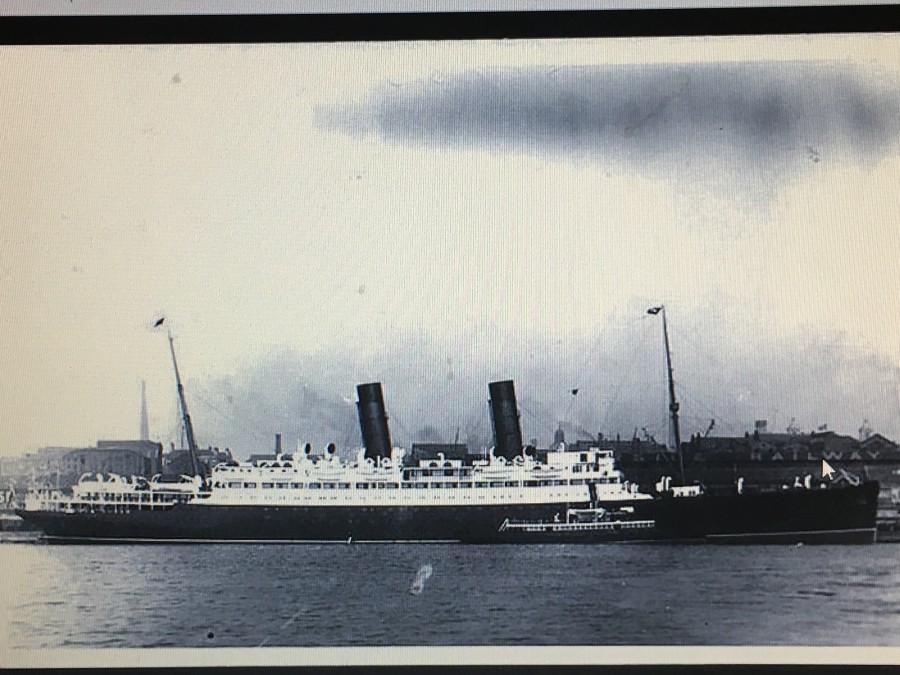
Kieran’s Our City, Our Town Article,
Cork Independent, 23 February 2017
The Wheels of 1917: The Sinking of the Laconia
One hundred years ago, World War I was raging just outside the entrance to Cork Harbour. German U-Boats patrolled the south coast of Ireland targeting British merchant vessels. Many were torpedoed and sunk. One such ship which met with two torpedoes, one hundred years ago this week, was the Cunard Ocean Liner Laconia. The seven-deck liner, complete with officers’ cabins on the top deck was launched in 1911. It was en route from New York to Liverpool when on on Sunday night, 25 February 1917 it was attacked with the loss of 13 passengers, including three Americans. The death of the Americans influenced the course of the war. A graphic account of the sinking by an American journalist Floyd Gibbons aboard was credited as one of the catalysts in pushing the United States into joining the war after it was read to both Houses of Congress.
Both the Gibbons account and the Cork Examiner on 28 February 1917 highlighted the plight of the Laconia, which was torpedoed about (11 km) northwest by west of Fasnet Rock. The first torpedo struck the liner on the starboard side on the stern side the engine room, but did not sink her. The effect of the torpedo explosion caused the big Cunarder to list to starboard, causing some difficulty in lowering the port lifeboats. She soon returned almost to an even keel before starting to settle, and all the boats—eleven in number got clear. By now the submarine had got into position for the firing of her second torpedo. Amongst the last to leave the ship and to jump into the water and swim to the boats were Captain William Robert Duncan Irvine and the chief engineer. The wireless operator, Mr O’Donovan. a native of Kinsale, sent out the SOS call. The ship’s surgeon, Dr Kennedy, a native of County Tipperary made sure that frail passengers were in lifeboats before he took to his own boat.
When all the boats were clear and the fate of the Laconia was no longer in doubt the German submarine came up alongside, and the commander opened conversation with a number of queries. His attitude, according to the press, appeared to have been one of cynicism and indifference to the fate of the boats, as when asked if he was aware that he was torpedoing a ship carrying women and children he is reputed to have replied, “Oh, they will be all right; keep on and a patrol will pick you up in a few hours. Good night”. Afterwards the submarine moved off into the darkness. The patrol boat that rescued the boats of the Laconia also rescued the crews of the steamers Falcon and Eires which had been sunk earlier on the Sunday. The patrol sloop drew alongside the deep water quay at Queenstown and the people of the town received 277 survivors. Motor cars and ambulances conveyed the survivors to temporary accommodation in the town’s various hotels.
A number of survivors, after leaving the torpedoed vessel, spent nine hours in a waterlogged lifeboat, until picked up by a mine-sweeper and taken to Bantry. Such was the impact to the exposure of the elements that out of 21 on the boat as many as seven died, and those included two American ladies, Mrs Mary Hoy and Miss Elizabeth Hoy. Rev V D Sargend, OP, who was travelling from the West Indies to England via New York, to take up an appointment as army chaplain noted that this boat was immediately launched after the torpedoing. There was no superintendence of the lowering of their boat and it hit the stern of the steamer while she was being lowered. Several of the side planks were burst open and it took sea water as it hit the water. From 10pm until 8am the boat drifted without oar or steering gear in this boat with rising water levels. They were not picked up until 3 o’clock that day. Everybody on board had crowded into the bows and stern. The big waves washed those who were in a weakened condition overboard. Mrs Hoy and her daughter, Miss Hoy of Chicago were two of the drowning casualties.
There were in all 23 American citizens on the ship and of this 17 were members of the crew. Two of the four surviving American passengers included Rev Father Waring of St Joseph’s Seminary, Baltimore, USA and Mr Floyd Gibbons of the Chicago Tribune. In Floyd account of the sinking of the Laconia he noted; “It was 10.30pm. Then came the five blasts on the whistle. [Gibbons gets into one of 10 lifeboats.] The ship sank rapidly at the stern until at last its nose stood straight in the air. Then it slid silently down and out of sight”.
In March 2009, it was announced that the wreck of the Laconia was located and claimed by Odyssey Marine Exploration, Inc, a commercial archaeology company in Tampa, Florida. Britain claimed it is the legitimate owner of the wrecks because, under a wartime insurance scheme, it paid the owners of the vessels when they sank, in effect making the remains the property of the British taxpayer.
Indices of and links to previous Our City, Our Town columns can be viewed at www.corkheritage.ie
Cork 1916, A Year Examined (2016) by Kieran McCarthy & Suzanne Kirwan is now available in Cork bookshops.
Cork City History Tour (2016) by Kieran McCarthy is also available in Cork bookshops.
Captions:
883a. Picture of Laconia, c.1912 (source: Cork City Library)
883b. Queenstown, now Cobh & the deep water quay, c.1917 (source: Cork Harbour Through Time by Kieran McCarthy and Dan Breen)
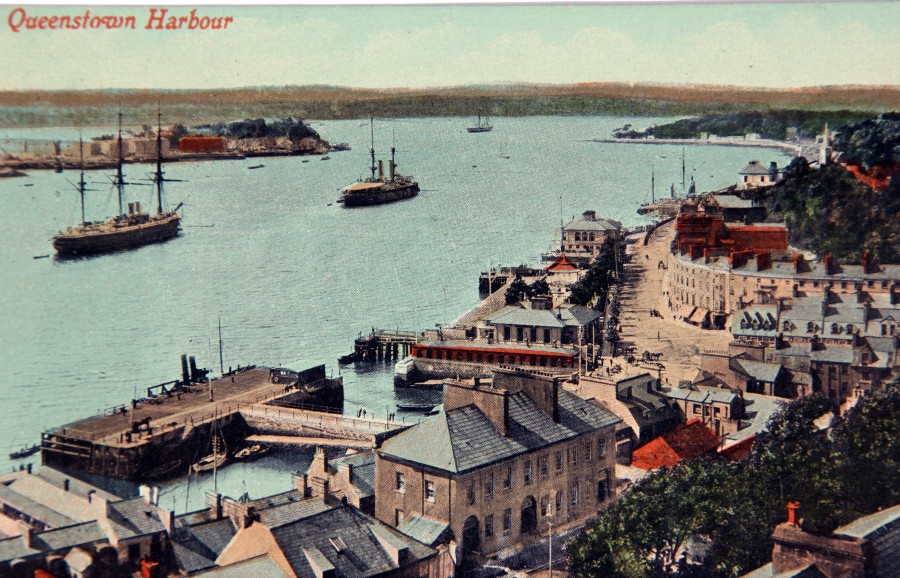
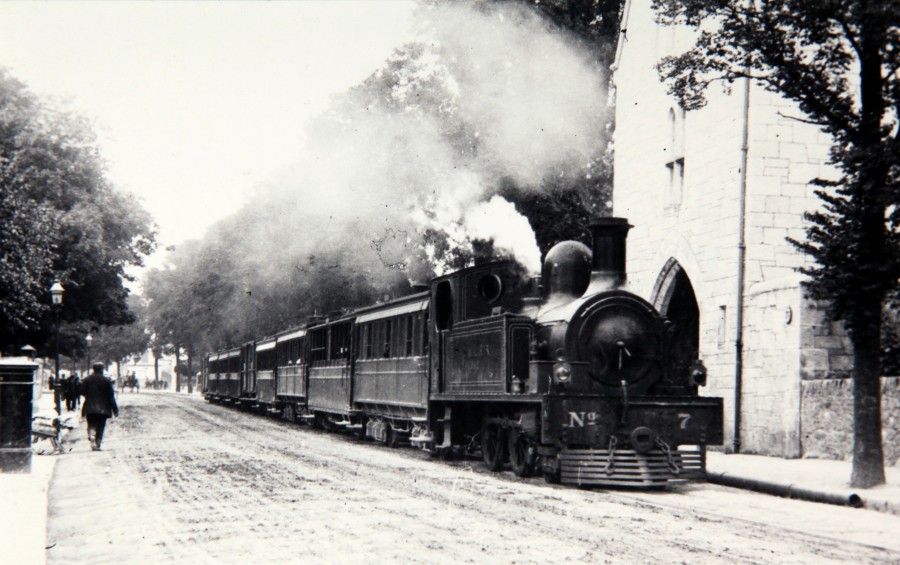
Kieran’s Our City, Our Town Article,
Cork Independent, 16 February 2017
The Wheels of 1917: Agriculture and the Cork-Muskerry Tram
One hundred years this week, on 20 February 1917, the Cork Muskerry Light Railway Company published their report for their annual general meeting in the Cork Examiner. The meeting was held at their offices on Western Road under the chairmanship of Mr George Colthurst (of Blarney Castle estate). The report gives insights into agriculture and the connections from the city into mid County Cork. The line was primarily built in the 1880s for tourists to link Cork to the tourist town of Blarney and its historic castle. Supporters of the railway line also aimed to provide improved transport for locals with livestock and farm produce between the farming area north-west of Cork and the city and for coal and minerals in the reverse direction.
Beginning on Bishop’s Marsh (now the River Lee Hotel), the Cork terminus was a single-storey building covered by a corrugated iron roof with a long platform. The iron engine and carriage shed spanned three tracks. the first four miles of the line going west were very like that of a tramway. From the terminus, the line crossed the south channel of the River Lee via a small bridge leading to Western Road. The iron supports for the bridge can still be seen. The initial stops were at Victoria Cross, Carrigrohane and then northwards to Leemount, Healy’s Bridge and Coachford Junction. there There were two branch lines, one to Coachford and the other from St Ann’s Hydro, near Blarney, which followed the Shournagh valley to Donoughmore.
In 1917 the physical railway line was deemed in a good condition but due to the war it was impossible to get timber sleepers. Two years previously, the railway company had placed an order for an engine but owing to war requirements they were unable to obtain the delivery of it. This, according to Mr Colthurst, placed them in a difficulty with regard to the repairing of their rolling stock. The company had been compelled to restrict somewhat their service of trains and were forced to take off the line two of their trains.
Financially the company was holding its own. The gross receipts for the company for the year end from all sources amounted to £12,072, as against £11,467 the previous year, which showed an increase of £605, compared with the corresponding period of 1915. Colthurst’s report highlighted that there were great increases in the numbers of boxes of eggs, fowl and butter carried over the line. The chairman noted that “it showed that the people of the country were returning to their old industrial pursuits and producing such commodities in abundance”.
Last year the Central Statistics Office published an account of agriculture based on contemporary statistics one hundred years. It denoted that farming was a significant industry for 1915-17 – there were 359,700 farms over one acre in Ireland whilst in 2010 the total number of farms had declined to 139,860 farms, a reduction of over 60%. In 1917 egg production made an important contribution to the rural economy, representing 11% of total agricultural exports from Ireland. Eggs were a consistent source of income and could be exchanged with local shopkeepers for crucial items such as tea and sugar which could not be produced on farms. The care of poultry and the income from eggs was normally a role taken on by the farmer’s spouse. It may have been her only source of independent income. The Department of Agriculture and Technical Instruction introduced initiatives for the improvement of egg production, including the establishment of egg production co-ops. Schemes to improve the breed of hen used and improvements in the packaging of eggs for exports were also introduced.
Colthurst at the Cork Muskerry Light Railway meeting highlighted increases in cattle and sheep carried over the Cork Muskerry line – cattle, 696, and sheep, 805 – but in pigs there had been a reduction of 66. The statistics from one hundred years ago reveal that most farms and small holdings kept a cow for milk for the house and liquid milk was not transported over long distances. In 1916, Dairy Shorthorn cattle were the predominant breed of cow used for milk production. Kerry cattle were utilised for milk production in Munster, especially in mountainous areas of Kerry and the Berehaven district of county Cork where larger breeds could not be kept. Kerry cattle were also kept on smaller holdings in Limerick, Cork & Tipperary. In 1916 beef production was primarily to produce live cattle for export. The main beef breeds in 1916 were Beef Shorthorn, Aberdeen Angus, Ayreshire, Hereford and the native Irish Dexter breed.
Colthurst in his report attributed the fault of the decrease in pig transport to the bacon curers who only paid low prices “for pork that would not enable the producer to produce pork”. From statistics, he highlighted that the number of pigs slaughtered in Ireland during 1916-17 was a little more than half of the number slaughtered three years previously. However the export of pigs was twice as much as it was three years previously. Many pig buyers took the pigs to England, where they were given a higher price for them than in Ireland. In general, almost 100% of Ireland’s exports in 1917 were to Britain, with Ireland mainly exporting primary products (i.e. products that required little or no processing such as live cattle, raw wool, eggs, etc). Today, the UK takes 41% of Ireland’s agri-export.
My book Inheritance, Heritage and Memory in the Lee Valley, Co. Cork (2010) is still available from www.historypress.ie (limited copies). It was based on a series of Our City Our Town columns on the histories and memories of Inniscarra and Dripsey.
Captions:
882a. Cork Muskerry Tram locomotive on Western Road, Cork City, c.1910 (source: Cork City Through Time by Kieran McCarthy & Daniel Breen)
882b. Cork Muskerry Tram locomotive on Western Road, Cork City, c.1910 (source: Cork City Through Time by Kieran McCarthy & Daniel Breen)
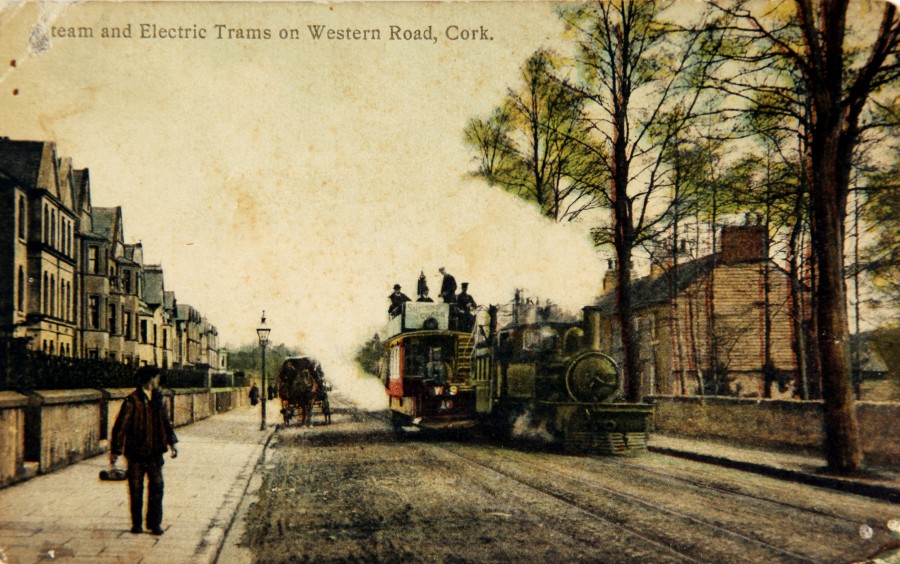
Press Release
Independent Cllr Kieran McCarthy has called for Cork City to rebrand itself as Ireland’s Southern Capital and lose such words as Ireland’s Second City- noting such terms as outdated and downgrading the city’s ambition. In this week’s debate with the City-County Expansion/ Merger advisory group under Jim MacKinnon, Cllr McCarthy cited his experience as a member of the EU Committee of the Regions to note that second tier cities within the EU, more than ever, are making their mark in the macro picture. He noted that Cork City should not be relegated to just a municipal district but should be scaled up to be an Atlantic Maritime City of Innovation. Commenting Cllr McCarthy; “This city has an obsession with looking towards Dublin but misses the opportunity to reconnect with cities in the Atlantic Maritime Region, where historically it traded with and had vast partnerships with. Cork punches way above its weight and is known by many European Commission officials who have visited Cork and the region on business and in a personal capacity as a holiday visitor. Small cities across Europe are tweaking, rebranding and repositioning themselves strategically in a very competitive European and global market of commerce. One gets to see that it is not a time for second tier cities to stay still or be diluted but an exciting time to explore their assets and to scale-up. There is a need to create a stronger narrative for Cork City and to scale up and reposition and capture its energy and expertise – not only as a strategic gateway in the south of Ireland but also in north west Europe”.
Continuing Cllr McCarthy commented; “Cities, large and small, in the European Union are now more than ever before, the powerhouses of economic growth, innovation and employment opportunities. Cities are facing ever greater social challenges in respect of the environment, transport and social cohesion. The Urban Agenda for the EU aims to address those challenges”.
“Vast sums of European structural funds are now being invested in cities and the public interest– to address poverty, housing, innovation, waste management, climate change measures; urban mobility. Much of Cork City’s key infrastructure, the last twenty years, has been for a large part funded by the EU – our new streetscapes, waste management, transport mobility, mechanisms and our larger public parks and amenities. We secure funds because we are an ambitious and strategic city with a vision for its future within a bigger picture – however whilst saying this we cannot secure large scale funding to provide ambitious housing and transport networks without enlarging the city’s boundaries and population. We cannot become part of eminent European urban projects such as Eurocities without have a population capacity of c.250,000”.
Cllr McCarthy stressed that in the macro picture, bigger cities are seen as stronger mechanisms that have population capacity, which can create better funding models: cross-sectoral financial instruments; they can simplify use of funds, and combine funds to more possibilities– the larger the city the more funding its attracts. “The potential for the future of Cork city is enormous. It has the potential to be a really important player in the development of this country but also a trusted player in the Atlantic Region of the European Union. Such ambition should not be thrown onto the fire of efficiency but should be allowed grow with the proper and most effective framework in place”.
Press Release
Independent Cllr Kieran McCarthy has warmly welcomed the initiative by the City Council’s tourism unit (TEAM) that it is in the process of establishing a Cruise Ambassador Programme on a pilot basis and will be working with external stakeholders i.e Port of Cork, Cork City Council City Centre Co-ordinator, CBA, Iarnród Éireann, Cork, and Visit Cork. It is anticipated that the cruise ambassadors will service more than 65 cruise liners, which are due to visit Cork during the 2017 season. The cruise Ambassadors will embark the ship on its arrival into port and interact with the passengers on board who are not already booked on the ship’s organised tours. Each Ambassador will provide a warm welcome to Cork and distribute necessary information such as maps, tourism information leaflets, and advise on all that Cork City has to offer the cruise visitor to enhance their visit.
Cllr McCarthy noted; “it is important that the city showcases its positive and scenic assets. Through giving tours of the city, tourists always enjoy exploring Cork’s ancient port city history; we have a great story to tell to visitors; the fact that over 60 per cent of people will arrive on one of the 65 cruise liners this summer with no pre-booked plan, there is a huge opportunity for stake-holders to come together to create a sustainable package to bring a large percentage of undecided cruise liner visitors from the harbour to the city”.
Press Release
Independent Cllr Kieran McCarthy has welcomed the addition of new interpretative signage at tourist strategic sites in Cork City. Fáilte Ireland have commenced with the installation of orientation signage as part of Ireland’s Ancient East at five locations in Cork City – Cork City Gaol, Blackrock, Butter Museum/ Shandon, Cork Public Museum/ Fitzgerald’s Park, St Finbarre’s Cathedral. The signs are strategically located at popular stopping points and inform visitors of nearby tourist attractions and points of interest that are part of Ireland’s Ancient East Story and within up to 60 minutes-drive away from the sign location and encourage visitors to extend their stay. The installation of further signs at other sites like the Lifetime Lab will happen shortly.
Whilst welcoming the signs, Independent Cllr Kieran McCarthy re-iterated his recurring point to the City Council’s tourism committee that it is important that Cork gets its share of publicity from Ireland’s Ancient East; “Additional interpretative signage telling Cork’s story is always great; But I am worried though from looking at the national picture – at the marketing campaign of Ireland’s Ancient East that there is a strong marketing focus on counties such as Meath, Carlow, and Kilkenny. This is also shown very clear on the marketing boards in Cork Airport and online. Cork City (and parts of the county to the north and east) as a southern terminus for the trail must get its fair share of publicity. The City was told 2-3 years ago that because we are not on the Wild Atlantic Way we would feature strongly on Ireland’s Ancient East. I acknowledge Fáilte Ireland has funded new heritage projects at the Lifetime Lab and Blackrock Castle but the publicity so far for Cork, I feel, has generally been underwhelming. I have called that we construct a stronger relationship with those in Fáilte Ireland driving Ireland’s Ancient East that we invite them into the committee to see what further work can be pursued.
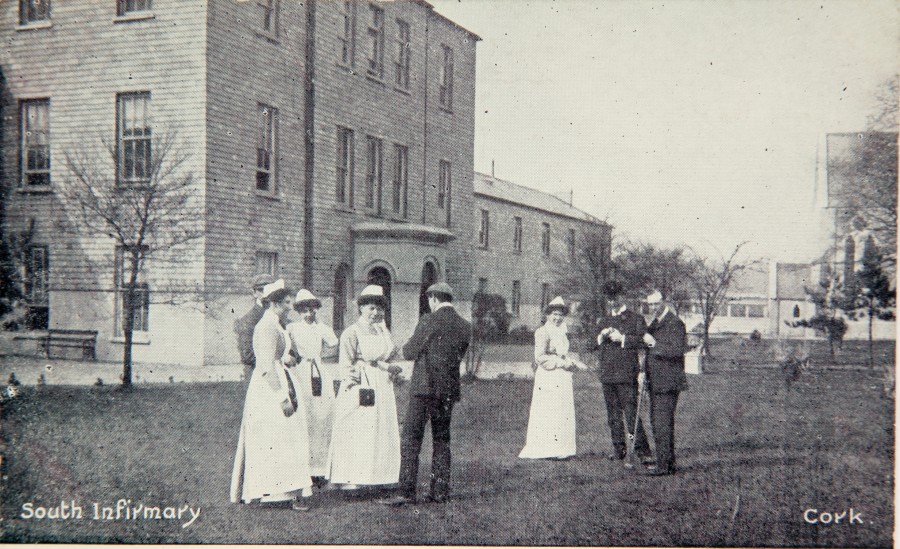
Kieran’s Our City, Our Town Article,
Cork Independent, 9 February 2017
The Wheels of 1917: Insights at the South Infirmary
One hundred years ago, 9 February 1917, the annual meeting of the Joint Committee of Management of the South Charitable Infirmary and County Hospital was held in the Boardroom of the institution. The Bishop of Cloyne Dr. Browne, chairman, presided with the report being published in the Cork Examiner. The report given on the hospital was extensive and gives another insight into everyday life in Cork a century ago and on the nature of the pressures on the health service for the ordinary citizen. The South Infirmary was opened in 1762 and was established by Act of Parliament. By 1917, the Victoria Hospital was in existence next door. Formerly known as the Women and Children’s Hospital, the latter institution was first located on Union Quay and then on Pope’s Quay. The move to be a neighbour of the South Infirmary occurred in 1885 and shortly afterwards an efficient training system for nurses was established. The name change to Victoria Hospital occurred in 1901.
The 1917 report highlighted what the South Infirmary deemed as “large numbers” applying for admission into the wards and attending at the extern departments. By arrangement with the military authorities over the previous two years the committee of the South Infirmary placed the entire male surgical ward at the disposal of the military authorities. The large number of 152 wounded and sick soldiers passed through the wards.
The medical and surgical report highlighted 484 medical cases passed through the wards. of whom 447 were discharged, cured or relieved and 37 died. The chief causes of death were acute lung and kidney diseases. The other deaths were largely due to the chronic affections found in a general hospital, and many of these were deemed “hopeless on admission”. In the surgical ward 598 cases were treated, and of these 561 were discharged or cured, whilst 34 died. Several deaths were due to cancerous cases on admission. The daily average number of beds occupied were 90.7%. The treatment of many cases, very many of a serious nature, and some requiring immediate operation, demanded much time and attention. There were 404 major operations performed during the year. A total of 3,109 new cases passed through the extern department, with a total attendance of 11,531.
Regarding staffing, the house surgeon Dr D P Lucy resigned in March 1916 having joined the Royal Army Military Corp (RAMC). Dr W P Lehane and Dr J C Saunders, former students of the hospital, were appointed house surgeon and house physician respectively. Dr G F Hegarty, after a year’s service with the RAMC, resumed charge of the X-ray department, which, during his absence was attended to by Mr H Lund. The concept of using X-rays in general hospitals was only about 15-20 years old. The hospital report regretted that owing to the high cost of building, they were not yet able to enlarge this department and complete its equipment. A special donation was received for it in 1913. The Lord Mayor, Thomas Butterfield, who was a dental surgeon by profession, found that the many calls on his time made it difficult to attend regularly at the South Infirmary’s dental department. He asked that a dentist be appointed to act with him during his term of office. Two were appointed. The onerous duties of the Matron were discharged by Sister M Albens Fogarty; her assistant was Sister M Cecilia. Miss A Henderson, who had been a member of the nursing staff for 7 ½ years, resigned in November 1916. She held the responsible position of staff nurse in the operation theatre.
In a finance sense, the hospital report highlighted that 1916 was an “extremely difficult and anxious year for the Joint Committee, and still more so for the House Committee”. The cost of everything connected with hospital maintenance continued to increase. There was often over 170 persons to be provided for in the Infirmary each day. The Matron lessened the distribution of food and coal but called for a warning to be given in the report; “it must be remembered that in the care of the sick there should not be any reduction in the amount of food or comfort required for their treatment. Apart altogether from the natural desire to do everything possible for the sick, it is false economy to reduce nourishment below what is necessary, as it means a longer stay in the hospital, and, consequently, more expense, besides, in many cases, depriving families of their breadwinners”.
Regarding funding and bequests, the hospital’s Joint Committee received during the previous year a bequest of £1,000 left by Dr A C Godfrey, of Broom Hill, Dripsey, for the endowment of “the Godfrey Bed’. A tablet was placed over a bed in the male surgical ward recording the name of the donor. A further £900, was made from the trustees of the will of Mr Joseph Bennett, of Warren’s Place, Cork, which became available on the death of his son, Mr Thomas F Bennett. The collections for the Hospital Saturday Fund and Hospital Aid Society amassed £53 and £40, respectively, to be allocated to the South Infirmary. The Joint Committee acknowledged the donations and the collection work of the Countess of Bandon, the Lady Mayoress, and the ladies of the city and county.
Indices of and links to previous Our City, Our Town columns can be viewed at www.corkheritage.ie
Cork 1916, A Year Examined (2016) by Kieran McCarthy & Suzanne Kirwan is now available in Cork bookshops.
Cork City History Tour (2016) by Kieran McCarthy is also available in Cork bookshops.
Captions:
881a. Postcard of former entrance to South Infirmary, c.1910; this main block has now been replaced by the modern hospital (source: Cork City Through Time by Kieran McCarthy & Dan Breen)
881b. Map of the grounds of South Infirmary, c.1910 (source: Cork City Library)
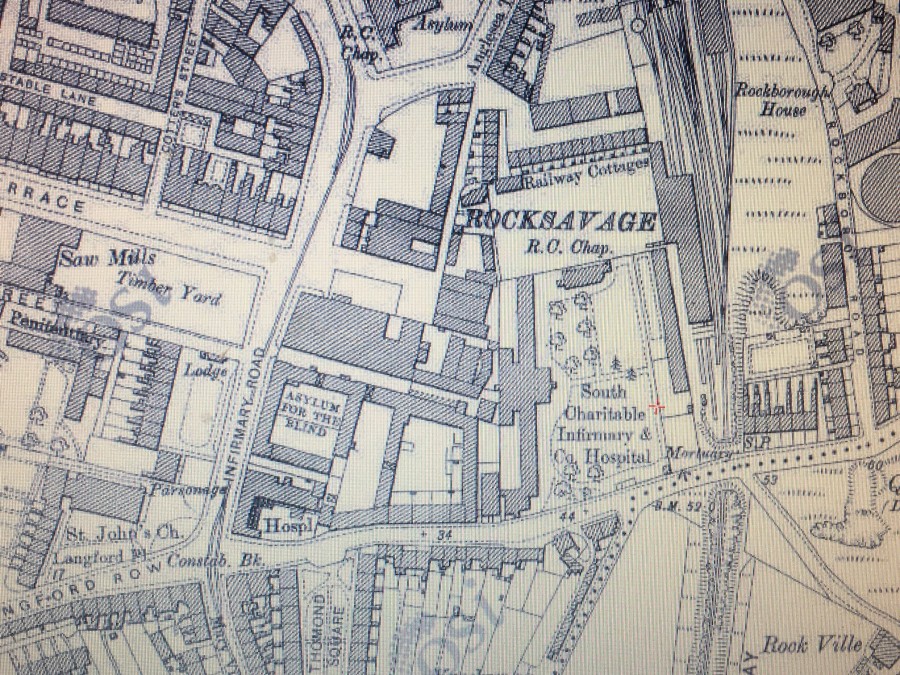
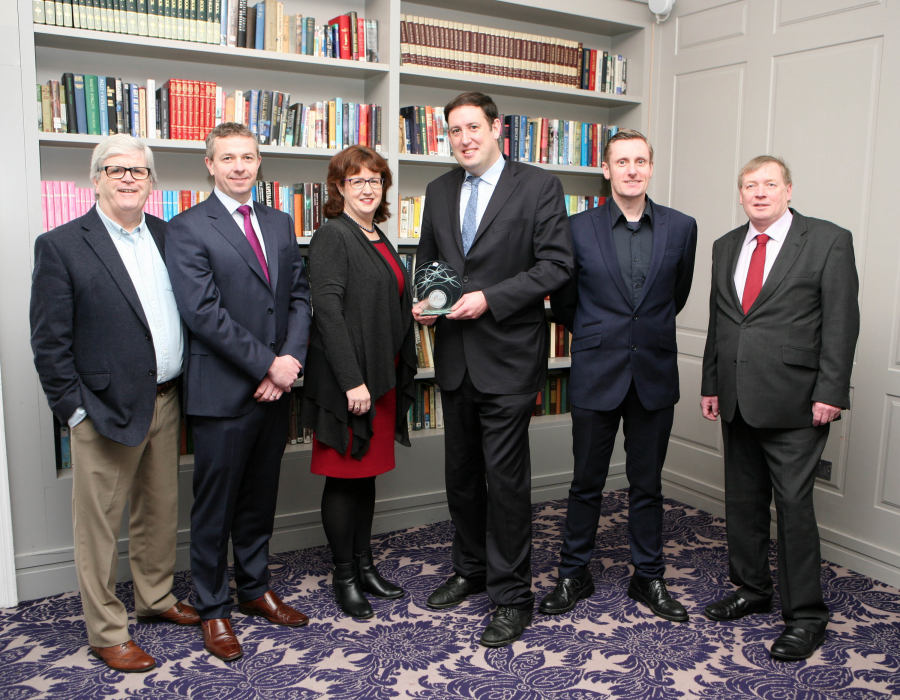
For over twenty years Kieran McCarthy has promoted Cork’s history and heritage and promoted its various communities and people.
His love of local history has inspired his many successful heritage initiatives and he has now received the January Cork Person of the Month award to mark his work.
Kieran organises local history walking tours, community talks, city and county school heritage programmes, newspaper history columns and has written nineteen local history books such as “The Little Book of Cork” and “Cork City History Tour – 2016”. Many of his articles can be seen on www.corkheritage.ie.
He is also an Independent Cork City councillor and a member of the EU Committee of the Regions. Recently as a mature student at UCC he gained a PhD in geography.
Over recent years he also started many youth projects such as the “Discover Cork: School’s Heritage Project”, McCarthy’s Community Talent Competition, and Cork City Musical Society.
“Cork has a great story to tell, one of ambition and determination, and it’s important we champion it and pass it on. I have always been passionate about Cork’s local history, both urban and rural, and especially in passing it on to the next generation” said Kieran at the award presentation.
This is the 25th year of the Cork Persons of Month award scheme and the Cork Person of the Year will be chosen from the monthly award winners in mid-January next (’18).

Kieran’s Our City, Our Town Article,
Cork Independent, 2 February 2017
The Wheels of 1917: A New Engineering Prospect
One hundred years ago, February 1917 coincided with a renewed focus on the value of engineering works for employment and industrial image in the region. The detail of the Ford project was progressing. In addition, in the first week of the local press, Passage West and its ship building industry came under scrutiny when its docks complex was purchased by the shipping magnate Messrs Furness, Withy & Co, Ltd. This was an enormous global firm, which provided the city and region an extra bargaining chip to the Westminster government on why the Ford complex should be sanctioned in Cork. Indeed, by the end of 1917, some 800 workers were employed at Passage West and Rushbrooke.
Passage West and Rushbrooke Docks were built by Henry Brown and William Craig, and were formally opened by Queen Victoria on her visit to Passage West in 1832, and the two dry Docks were named respectively the Royal Victoria Dock and Albert Twin Dock. The town of Passage West flourished and prospered because of the large amount of employment given in the consultation and repair of ships. Serving the town was the Cork, Blackrock and Passage Railway, which was opened from Cork to Passage in 1850, and extended to Crosshaven in 1904. It was 16 miles long and served the important shipbuilding centre at Passage West, the well-known residential district of Monkstown, the rich agricultural area around Carrigaline, and the famous seaside resort of Crosshaven.
The Rushbrooke Dock was built by the late Joseph Wheeler in 1860. He was an extensive shipbuilder in Cork, where he built many sailing ships for local and other owners. The rapid growth of other shipyards to cope with the advancing types of ships in England and elsewhere affected Passage, and for some years a period of depression ensued. The fate of the docks and the town was a matter of anxiety. The facilities offered a fine waterway but lack of investment capital.
In 1880 the Passage West and Rushbrooke Docks passed into the hands of entrepreneur Sir John Arnott, from whom they were again subsequently purchased by the Channel Dry Docks Shipbuilding and Engineering Co, Ltd, in 1898. In 1900, there was talk of Harland and Wolfe coming to Monkstown and, although there was much enthusiasm for the project, it never materialised. In 1910, the Managing Director, Mr Oliver Piper, purchased the Docks himself. It was Oliver Piper who brought Winston Churchill, the First Lord of the Admiralty, on a guided tour of the Royal Victoria Dockyard when he came to view Cork Harbour in the summer of 1912. It was hoped that the visit would result in Admiralty work for the dockyard. When Furness & Withy purchased the site from Piper he continued to work them until March, 1917. He then went on to create the Queenstown Dry Docks firm, which pursued work for Furness & Withy.
Mr Piper on 5 February 1917 in the Cork Examiner noted on the takeover of his firm; “the Docks have been acquired by the very important firm of ship-owners, Messrs Furness, Withy and Co, Ltd, of London. Liverpool and Hartlepool, whose phenomenal rise in such a few years to the very highest position in shipping is an indication of the ability and energy of its directors. They have been satisfied by their personal investigations and reports that the South of Ireland is virgin soil, and has potentialities of very great importance to a shipping corporation possessed of the ability, energy and immense resources that the purchasing company enjoy”.
London’s National Maritime Museum denotes of the international reputation of Messrs Furness Withy & Co that it was was incorporated as a company in 1891 upon the amalgamation of Christopher Furness’ business in West Hartlepool and London with Edward Withy’s shipbuilding yard in Hartlepool. By 1914 the company had acquired interests all over the world in liner and tramp shipping and in shipbuilding, but from 1920 they concentrated on liner services.
In 1911 Furness Withy acquired a large holding in Houlder Brothers and the company’s British & Argentine’s vessels were operated in association with those of the Houlder Line. In 1914 the Furness-Houlder Argentine Lines was incorporated for the purpose of building a fleet of large, fast twin-screw steamers for the conveyance of chilled and frozen meat from the River Plate to London in conjunction with the Royal Mail Steam Packet Co, Furness Withy and Houlder Brothers. There were other additions to the company. The Prince Line was purchased in 1916 and with this services were developed to the Mediterranean and from New York to the Far East and the River Plate. The River Syndicate was incorporated in 1920 to acquire a controlling interest in the Danube shipping which had formerly belonged to South German, Austrian and Hungarian companies. In the late 1920s and early 1930s the company sold of several of its non-profiting shipyards of which Passage West Docks was one.
In 1931, the site of the Royal Victoria Dockyard was purchased by a new company, Haulbowline Industries Ltd (HIL). The Harbour Board supported the HIL shipbreaking venture by decreasing tonnage dues on metal from scrapped ships. The company still focusses in the trade of scrap iron and today, some loading and unloading of cargo is also completed at the dockyard.
Indices of and links to previous Our City, Our Town columns can be viewed at www.corkheritage.ie
Cork 1916, A Year Examined (2016) by Kieran McCarthy & Suzanne Kirwan is now available in Cork bookshops.
Cork City History Tour (2016) by Kieran McCarthy is also available in Cork bookshops.
Captions:
880a. Passage West from Glenbrook, c.1910 (source: Cork Harbour Through Time by Kieran McCarthy & Dan Breen)
880b. Wall of former Royal Victoria Dockyard, Passage West, present day (picture: Kieran McCarthy)
